Sensors
Optical, Inductive, Capacitive, Ultrasonic, IR sensors, Labelsensors, Pressure, Vacuum, Pitot pressure switch, Level control, Mechanical switches, Temperature sensors
Capture values
People counting, presence detection, temperature data acquisition, humidity data acquisition, leakages, filling levels
Separation & Switching
Solid-state relays, Solid State Contactors, Solid State Reverse Contactors, Motor circuit breakers, Overload relays, Contactors, Reversing contactors
Automation
Controllers, PLC, Timer, Control relays, Solid state relays, Optocouplers, Counter, Temperature controls, Transmitters, Power supplies, Displays, Motors
Operating & display
Pushbuttons, rotary switches, touch panels, bargraph displays, process displays, empty and complete housings
Climate technology
Climatic transmitters, data loggers, liquid manometers, handheld instruments, measuring probes
Distribution, wiring
Connection cables, Extension cables, Jumper cables, PVC+ cables, PUR cables, Connector, Custom cables
Ex Zone
Ex Pneumatic, Ex sensors, Ex mechanical switches, Ex terminal boxes, Ex control functions, Ex linebushings
Information
| User Online: |
777 |
| Counter: |
85488889 |
|
Sensor KnowHow |
for a safe start and to clarify uncertainties |
|
|
On this page you will find the basics about the sensors. This information will help you to make the right decisions. The information is kept simple and is clarified with drawings.
Of course, our technicians are always available for further questions or explanations via LiveCall, chat, email or on the phone.
|
|
 |
The difference between PNP and NPN
|
|
The designation PNP and NPN at the sensors has nothing to do with the function (e.g. normally closed or normally open) of the sensor! It is about the wiring of the output transistor. A PNP sensor can have the function NO (normally open) or NC (normally closed).
|
|
|
|
|
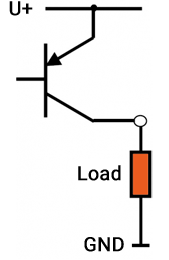
|
|
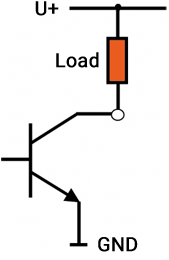
|
|
|
|
PNP switching output
|
|
NPN switching output |
The load at the switching output is connected to GND as reference point. When a signal change occurs due to the attenuation of the sensor, the supply voltage (U+) is "switched through". The current can flow from U+ through the transistor and through the load to GND.
The PNP switching output is preferred in Europe.
|
|
The load at the switching output is connected against U+ as reference point. When a signal change occurs due to the attenuation of the sensor, the ground (GND) is "switched on". The current can flow from U+ through the load via the transistor to GND.
The NPN switching output is preferably used in Asia and North America.
|
|
|
 |
Normally open, normally closed and changeover contacts
|
|
The switching function of a sensor is defined by the terms normally open (NO), normally closed (NC) and changeover contact (NO/NC).
|
|
|
|
|
|
|
|
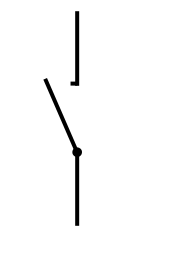
|
|
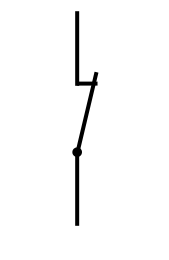
|
|
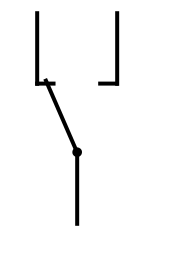 |
|
|
|
|
|
Normally open (NO)
|
|
Normally closed (NC)
|
|
Changeover (NO/NC)
|
A normally open contact establishes the electrical connection when the sensor is damped. In the idle state, the connection is open and no current flows.
NO = normally open
|
|
A normally closed contact disconnects an electrical connection when the sensor is damped and is closed in the idle state.
NC = normally closed
|
|
With a changeover contact, the connection is switched to another contact when the sensor is damped. When the damping is removed, the connection switches back to the normally closed contact.
|
|
|
 |
| Sensor functions |
|
Not all sensors are the same. Each application requires the right type of sensor. The different designs offer different advantages and disadvantages. Here we explain the function of the individual sensor types and their advantages.
|
|
Triangulation, background suppressor
|
| Diffuse reflecting objects are detected within the set switching range. Backgrounds or objects outside the switching range are electronically blanked. |
|
|
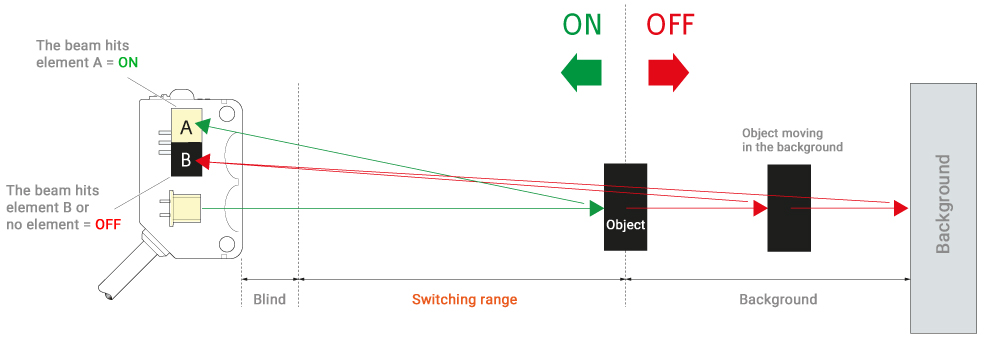 |
|
Advantages of background suppressors
|
|
- Detects diffuse surfaces within the sensing range
- Minimal influence due to color differences
- Objects outside setting range are not detected
|
|
| Triangulation, foreground suppressor |
| The sensor is set to a reference surface. The switching window lies closely on the reference surface. The object blocks this optical axis, the sensor switches. |
|
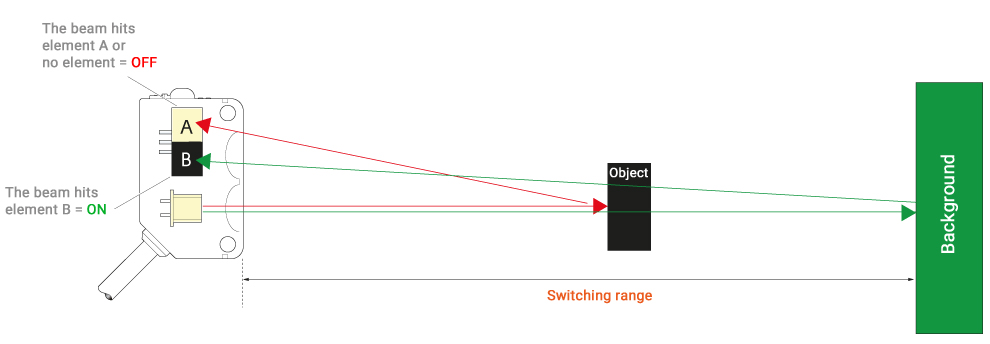 |
|
| Advantages of Foreground Suppressors |
|
- Defined reference distance
- Surface condition has no influence
- Object non-uniformity has no influence
- No close range
- Detects also reflective surfaces
|
|
| Convergent sensor |
Convergent sensors detect objects only in a certain detection range (area).
|
|
 |
|
| Advantages of Convergent sensor |
|
- Short distance sensor
- Defined detection range
- Surface condition has low influence
- Mostly very small designs
|
|
| Light barriers |
| Light barriers always consist of a transmitter and a receiver and can reliably bridge large distances. The well-focused light beam can penetrate dust and fog. The light beam must be clearly interrupted to obtain a reliable switching situation. |
|
 |
|
Advantages of Light barriers
|
|
- Long distances
- Pollution penetration
- No close range
|
|
| Retro-reflective sensors |
Retro-reflective sensors are aligned and adjusted to a defined reflector. Such sensors are also well suited to detect transparent objects.
|
|
 |
|
| Advantages of Retro-reflective sensors |
|
- Only one-sided wiring
- Detects transparent objects
- Defined switching zone
- No close range
|
|
| Diffuse |
he optical diffuse sensor evaluates the surface reflection from the object. Depending on the reflectance, the switching distance is larger or smaller. Usually these sensors work with infrared light, laser or with visible red light.
|
|
 |
|
Advantages of Diffuse sensors
|
|
- Detects most surfaces
- Transmitter/receiver in one device
- No close range
|
|
| Coaxial sensor |
|
Diffuse sensors, background suppressors or retro-reflective sensors can be influenced by other nearby design elements. This is mainly due to 2 reasons:
- Due to the large aperture angle of the transmitter, light is reflected by other constructive parts. The receiver recognizes the light signal and switches!
- Transmitter and receiver elements are placed constructively one above the other in the sensor. This has the consequence that always the transmitter or the receiver is in the shade.
In comparison, the coaxial LASER sensor has the transmitter and the receiver on the same axis. This means that the bundled and reflected light can reach the receiver on the same axis.
|
|
 |
|
Advantages of Coaxial sensor
|
|
- Transmitter and receiver on one axis
- Can detect through holes and gaps
- Very small close-range
- Small light spot
|
|
|
|
|
|
|
|
|
|
|

